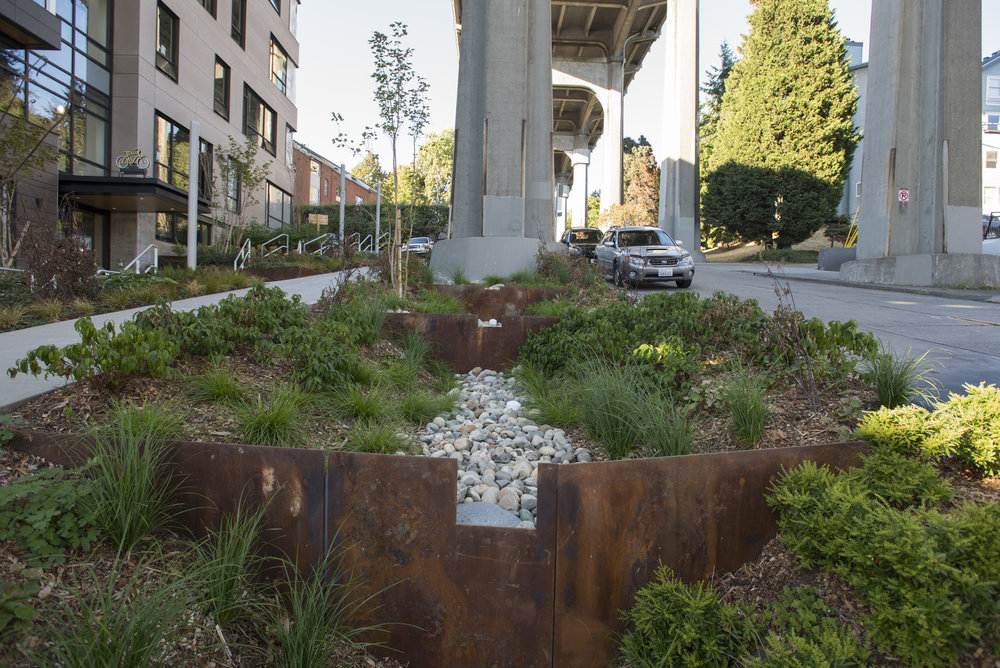Openness, Collaboration, and Co-Creation:
Realizing the Full Potential of Nature-Based Solutions

By Mark DeLaurier
The potential for nature-based solutions (NBS) continues to rise, and new research points the way toward realizing those possibilities with seven lessons from previous projects around the world.
Drawing from earlier case studies of NBS, Dr. Niki Frantzeskaki, a researcher at the Dutch Research Institute for Transitions, compiles these lessons in a journal article titled Seven Lessons for Planning Nature-Based Solutions in Cities, revealing a need for cities to take new approaches that prioritize collaboration and open dialogue with citizens and community organizations.
Even the first lesson, which concerns aesthetics, contains implications and opportunities for public engagement.
“Nature-based solutions need to be aesthetically appealing for citizens to appreciate and protect them.”

Photograph by Hannah Letinich
Photograph by Hannah Letinich
That sounds pretty simple. Make something that looks good, right? Well, that is technically true, but it misses a lot of possibilities. Rather than just creating something it thinks the public will like, a city should engage citizens, artists, and architects to define and co-create the solution. Asking people what they think looks good and natural and soliciting ideas from them about how it can be created helps the public feel invested in the solution.
In fact, every step of the process provides chances to bring the public on board and build relationships. For example, cities should embrace the sense of place that springs up around NBS. Such spaces should be managed as new urban commons, encouraging and maximizing public involvement in their creation and maintenance. This approach increases public investment, “fosters acceptance and appreciation of cultural diversity,” and creates “new relations between nature and people.”
The third lesson from the research indicates that the experiments used to develop NBS “require and build trust between the city and its citizens both for the aim of the experiment and for the experimenting process itself.” For this to happen, it is crucial that cities see citizens as having ideas equal to those of experts and treat them accordingly by committing to “clarity, transparency, and openness”. Once trust is established and people feel comfortable contributing, the experimentation for the project benefits from the community’s knowledge and talents.
To overcome the barriers that often limit public engagement, with the fourth lesson, cities need to foster and utilize new participation forums. For instance, cities can use luncheons and dinners as venues for public discussion, attracting more people and generating a less formal atmosphere that minimizes perceived power imbalances between the public and city officials. And to diversify the methods of participation, cities can encourage citizens to bring pictures, narratives, and sketches of what they think the project should look like. These forums should emphasize and facilitate co-creation of the NBS, and the city should change its role “from regulating and consulting to enabling, participating, and facilitating citizen-led projects and dialogues.” The end result empowers the community and nurtures environmental responsibility.
As the NBS moves toward implementation, the need for community engagement grows. The fifth lesson holds that NBS require collaborative governance. Although a local government might initiate a project, the design, implementation, and long-term health of the project depend on other actors as well. Some projects even transfer to citizen groups for stewardship.

Bringing people together to support an NBS requires a message that encapsulates its openness and focus. As a result, in her sixth lesson, Dr. Frantzeskaki calls for “an inclusive narrative of mission.” To create such a message, she recommends using the main objective of responding to climate-change pressures and communicating the benefits of the project. Emphasizing the various benefits allows people from different departments and organizations to see the value of their involvement.
Finally, with her last lesson, Dr. Frantzeskaki calls for NBS with a small enough scale to ensure that other cities can replicate the ideas. City-to-city networks provide vital resources for finding NBS. To take full advantage of these resources, however, cities need solutions with simple designs.
The lessons of this research show that success of NBS lies in the processes for creating, instituting, and managing them. Start with a commitment to trust and dialogue based on equity, establish clear channels of communication and a focus on public benefits, unleash the shared resources of the citizens, and watch NBS produce resilient, vibrant communities.
To read the full article, click here!

Photograph by Mary Eidmann
Subscribe to our e-mail list.
Stay up-to-date on how we are building a movement around nature in cities - including the latest stories from the blog and upcoming events.
© Kevin Arnold
